Human Gene Transfer Studies: What Clinicians Should Know
Applied Clinical Trials
This experimental technique is being studied to see whether it could treat certain health problems.

Human gene transfer (HGT) is defined as the transfer of genetic material (DNA or RNA) into a person. This experimental technique is being studied to see whether it could treat certain health problems by “compensating for defective genes, prompting the body to make a potentially therapeutic substance, or triggering the immune system to fight disease.”[1] There are a number of different techniques for introducing the recombinant or synthetic DNA into the body, including both ex-vivo (outside the body) and in-vivo (inside the body) integration into the human genome (See Figure 1 below). HGT research is sometimes called "gene therapy" research, although many researchers and ethicists prefer not to use the term “therapy” to refer to products which are still investigational. HGT research is now being tested in a wide number of
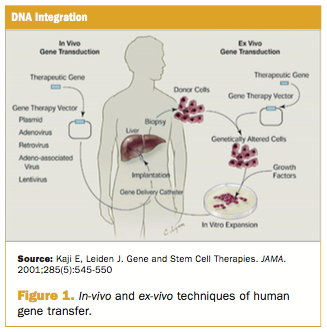
therapeutic indications (See Figure 2 below).
The first clinical trial of an HGT product was initiated in 1989, and the number of new trials started to grow quickly over the next 10 years. The field of gene transfer research was set back in 1999, after the death of 18-year-old Jesse Gelsinger in a trial at the University of Pennsylvania. Gelsinger suffered from ornithine transcarbamylase deficiency, an X-linked genetic disease of the liver. The symptoms include an inability to metabolize ammonia, which is a byproduct of protein breakdown. The disease is usually fatal at birth. But Gelsinger had not inherited the disease; in his case, it was apparently the result of a spontaneous genetic mutation. Some of his cells were normal, enabling him to survive on medication and a restricted diet. On September 13, 1999, Gelsinger was injected with an adenoviral vector carrying a corrected gene as part of a clinical trial to assess the safety of the gene transfer product. He died four days
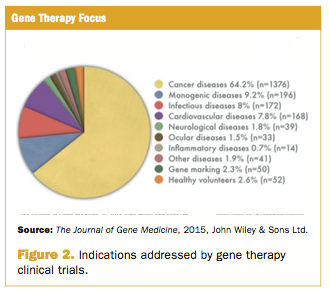
later, apparently having suffered a massive immune response triggered by the use of the viral vector used to transport the gene into his cells, leading to multiple organ failure and brain death. A number of concerns were subsequently raised about this clinical trial, regarding the adequacy of the consent process, his full awareness of the potential risks, and the conflict of interests of the investigator who had created and patented the gene transfer product. The resulting concerns about the field of gene transfer research slowed growth in the number of studies initiated and, consequently, slowed progress in this area of research for several years.
Between 1989 and the beginning of 2015, approximately 2,000 trials have begun (see Figure 3). About 195 companies have gene transfer products in clinical development at this time,[2] and many of them are working with contract research organizations (CROs) on the design and conduct of studies in these clinical programs.
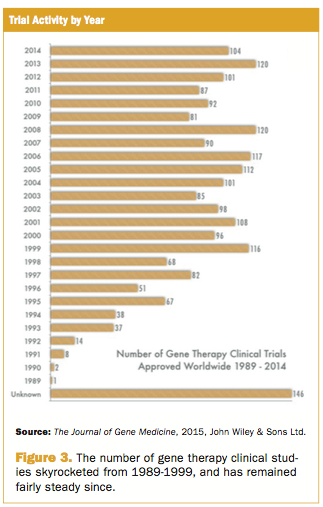
How is human gene transfer research different from small molecule drug development?
In many ways, the design and conduct of clinical trials of HGT products are similar to those evaluating small molecule drugs or non-HGT biologic products. But there are some important differences to consider in the planning of HGT clinical development programs and individual studies.
Regulatory oversight
In the U.S., many HGT products have been developed with support from the National Institutes of Health (NIH). This support may have been to an academic institution at which the product was first created or researched, or in some cases provided directly to the biopharma sponsor. The provision of this funding provides a mechanism for NIH oversight of this HGT research. Even if the funding period has ended, the NIH Office of Biotechnology Activities maintains authority over the development of the product. Once one dollar of NIH funding is attached to the product (which may include the technology platform on which the product was based), the NIH oversight attaches as well.
Knowing exactly when the NIH oversight applies can be tricky. If the funding was given to the biopharma sponsor, the NIH oversight applies to all the clinical sites in the study run by that sponsor. If there is NIH funding for recombinant DNA research at an institution that is one of the clinical sites, NIH oversight applies to all recombinant DNA research done at that institution even if the research is using a different product or the funding is given to a different investigator at the institution. NIH oversight may also apply to clinical study sites in countries outside the U.S., unless that country has equivalent policies and protections for the use of recombinant DNA products. Therefore, NIH oversight may apply to all, some, or none of the clinical sites in any multi-center clinical study, and expert advice may be necessary to be certain of the appropriate regulatory obligations.
The specific requirements of the NIH oversight are provided in the NIH Guidelines for Research Involving Recombinant or Synthetic Nucleic Acid Molecules[3] (commonly referred to as the “NIH Guidelines”). The NIH Guidelines is a dynamic document that is periodically updated with the science and understanding of recombinant and synthetic nucleic acid molecule research. In 1990, a new section was added to the NIH Guidelines, Appendix M, which describes points to consider in the design and submission of HGT trials, including the standards and procedures to which investigators must adhere.
The NIH Guidelines also describe the role of the NIH Recombinant Advisory Committee (RAC). The RAC makes recommendations on research involving the use of recombinant DNA and on developments in recombinant DNA technology. Gene transfer trials using recombinant DNA fall under NIH oversight and require registration and potential convened review through the RAC. The RAC’s role is to conduct risk assessment reviews of the protocols for HGT products, if it considers a specific risk assessment is necessary. The RAC applies the NIH Guidelines standards for investigators and institutions to ensure the safe handling and containment of gene therapies. As more viral vector delivery systems are becoming standard and the risks are better understood, the RAC frequently declines to review research using these more common systems and only convenes to review novel systems.
Involvement of IBC
In addition to providing risk classification information for specific biologic compounds, the NIH Guidelines outline requirements for institutional oversight of gene transfer research and for the constitution and conduct of institutional biosafety committees (IBCs). While the role of an institutional review board (IRB) in human subject research is to protect the rights and welfare of the study participant, the IBC’s role is to protect those around the study participant; the research team, the participant’s family and contacts, and the public. Although the IRB regulations allow the use of a “central” IRB (an independent IRB, not based at the research institution), the IBC must be a local committee; that is, committee members must be at or near the institution at which the research will be conducted, although the administration and management of the IBC can be “centralized.”
The IBC reviews not only the protocol, but also the clinical site’s physical qualifications, including the policies and procedures for the safe and appropriate storage, handling, and administration of the gene transfer product, based on the product’s biosafety risk level. If a clinical site has not conducted any HGT research before, and does not conduct non-clinical research with recombinant DNA products, this may mean that an IBC needs to be created to review the protocol at the clinical site to maintain compliance with the NIH Guidelines. Like IRB approval, IBC approval must be obtained before any clinical trial of HGT research can be initiated, and approval must be maintained through periodic review during the study.
The institution’s IBC has oversight of the practices and operating procedures governing the lifecycle of the product at the dosing institution. The IBC will review the standard operating procedures for these processes. These include receipt of the product, storage of the product on site in appropriately labeled biohazard freezers and liquid nitrogen containers, and transport from storage to the dosing preparation areas. The IBC will review the physical manipulations involved in product preparation and determine whether personal protective equipment for research staff (e.g., masks, eye shields), or engineering controls such as preparing injections inside a biosafety cabinet, are indicated. The IBC will also review the product administration process (e.g., injection, infusion, etc.).
This oversight is in addition to the FDA regulations for the development of biologic products. FDA has also created a number of guidances and FAQs related to the development of HGT products.[4] The European Medicines Agency (EMA) has drafted guidance for the development of HGT products as well.[5]
Site selection and preparation
One of the most challenging areas for sponsors and CROs is how to evaluate a site for potential participation in a HGT trial. Most sponsors and CROs are unaware of the role that NIH has with regards to HGT trials in the U.S., along with the standards and guidelines for initiating gene transfer trials. Many institutions also have local standards which are beyond the NIH Guidelines which they consider to be “best practice.”[6],[7]
The NIH Guidelines and the requirements of the Centers for Disease Control (CDC)[8] require the IBC to assess a clinical site to a biosafety level which is based on the risk assessment of the biological agent (and is different from the adverse event profile of the investigational product). No standard definitions of biosafety levels have been generated for clinical settings, so IBCs default to applying the biosafety level definitions developed for laboratory work. For most gene transfer products, the IBC will require the clinical site to conform to Biosafety Level 2 requirements. These include requirements such as having eyewash stations available in case of splashing or eye exposure, bare floors (no carpet) that can be cleaned in case of spills, and enclosed spaces (as opposed to an open floor plan) that can be closed off for decontamination in the event of an accidental product release (broken or dropped vial, etc.).
The process of evaluating sites for participation in a HGT study has to look not only at the usual requirements for any clinical trial (experience, resources, potential subject population, basic facilities) but at their ability to meet or to become prepared to meet the additional standards required by the biosafety level assessment, additional safety controls, and IBC review process. If the site has never participated in an HGT study before, they may need to develop and document new procedures, and to train all their staff who will be involved in the study.
Endpoint selection
While basic guidelines for the selection of efficacy assessments in specific therapeutic areas should be followed, the timing of efficacy assessments may need to
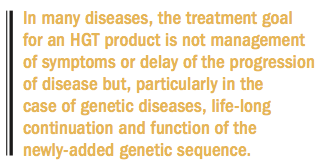
be modified in studies of HGT products. In many diseases, the treatment goal for an HGT product is not management of symptoms or delay of the progression of disease but, particularly in the case of genetic diseases, life-long continuation and function of the newly-added genetic sequence. Therefore, assessment of the efficacy endpoint should be evaluation with an appropriate duration of follow-up, which may even persist into post-marketing requirements.
Safety monitoring
There are novel considerations in the safety assessment of an HGT product. Some of the potential safety effects may need to be assessed in specific non-clinical studies, but they may also have implications for safety monitoring in the human studies.
Since many HGT products create an immune response, immunogenicity should be assessed in non-clinical studies and considered in the selection of the population and in the safety monitoring plans. This is especially important in pediatric or elderly populations, who may have different immune responses compared to adults, based on whether or not they have had prior exposure to, or vaccination with, the viral vector being used. Instructions for the assessment of safety monitoring should specifically include the assessment of infusion-related reactions, infections, and inflammatory responses, and immune-mediated adverse events.
When live viral vectors are used in the product, clinical trial eligibility criteria should contain an assessment of immunosuppression, including the presence of immunosuppressive illnesses (HIV infection, etc.) or concomitant use of immunosuppressive medications. After administration of the product, “shedding” of the virus is also possible. Shedding refers to the potential for the participant to whom the product has been administered to continue to secrete the virus in their bodily fluids. This can include direct leakage of the virus from the injection site after administration, when the skin puncture is still open or through a lesion that forms at the site. Viral shedding creates a safety issue not just for the participant, but creates the potential for infection of family, friends, and even casual contacts. The potential for shedding should be assessed in non-clinical studies, but human shedding studies may also be performed to assess this risk. Protocols may need to specify the use of waterproof, occlusive dressings over injection sites and/or the resulting lesions, rather than use of gauze or other common bandages.
Human DNA contains many sequences that turn the translation of other DNA sections on and off. When DNA is introduced into the research participant with the use of a viral vector, the DNA can be incorporated into the DNA of the participant’s cell, but the precise location of that integration cannot be controlled. It is possible that the new DNA can be incorporated into a location which accidentally turns on a tumor-promoter gene (or turns off a tumor suppressor), which is called “insertional oncogenesis.” Non-clinical studies to assess tumorogenicity may be conducted, but long-term follow-up for secondary cancers may also be necessary in clinical trials.
Some HGT products are introduced into specific tissues rather than being administered systemically; for example, administration of a gene transfer product using an adenovirus vector into the eye for the treatment of macular degeneration.[9],[10],[11] In such cases, safety monitoring should also watch for the distribution of viral vector beyond the intended tissues.
Informed consent
The NIH Guidelines provide guidance on four topics in addition to the standard required elements of informed consent that are considered necessary to include in trials of HGT products. While IBCs will review the informed consent document to see if these issues are addressed, they do not “approve” consent documents; they will provide feedback to the researcher, sponsor or the appropriate IRB if they feel that these elements are not adequately addressed. The topics are:
- Reproductive Considerations - When existing data are inadequate to rule out the possibility of inadvertent germline alteration that could be passed on to offspring, participants should be informed that the consequences to unborn children are unknown.
- Long-term Follow up with rDNA- Prospective participants should be aware that they will be expected to participate in long-term follow up that extends beyond the active phase of the study. Investigators should explain the rationale for long-term follow up and describe the specific follow-up activities planned, including the desire to collect information about any new cancers, blood disorders, autoimmune diseases, and neurologic disorders encountered.
- Request for Autopsy - The request to be allowed to perform an autopsy in case of the participant’s death is an aspect of long-term follow up that is unique to gene transfer, since it is still such a new area of research. It is requested because autopsies can yield important information that may enable a better understanding about the long-term effects of gene transfer intervention.
- Interest of the Media and Others - This issue was added shortly after the Gelsinger case, when it was thought necessary to warn participants that there may be public interest in their trial and participation. While generally considered much less necessary now, this item has not been removed from the guidance.
Summary
The number of HGT products in development is increasing, and the number of these clinical trials is increasing. As this trend continues, more clinical research professionals within biopharma sponsors and CROs, who may be well-versed in the details of drug and/or biologic development, may find it necessary to be aware of the specifics of the design and conduct of HGT studies. This will be necessary to ensure that these trials are conducted with regulatory compliance, scientific rigor, and the best protection for the participants as well as the researchers and the public. This paper has provided only a brief summary of some of the key challenges unique to gene transfer clinical trials. The field is constantly changing as regulatory bodies develop and evolve frameworks that will impact the conduct of these types of trials. As these products pass through proof-of-concept assessments, gain financial support, and progress into later-stage clinical trials, it is important that clinical research professionals keep up with the additional challenges of successfully conducting these trials.
References
1. NIH Backgrounder on Gene Transfer; http://www.nih.gov/news/pr/nov2002/genetransferbackgrounder.htm. Accessed 8 July 2015.
2. Jain Biotech Gene Therapy – technologies, markets and companies. http://pharmabiotech.ch/reports/genetherapy/. Accessed 8 July 2015.
3. NIH Guidelines for Research Involving Recombinant or Synthetic Nucleic Acid Molecules.
. Accessed 8 July 2015.
4. FDA Cellular and Gene Therapy Guidances; Cellular and Gene Therapy Guidance Documents. http://www.fda.gov/BiologicsBloodVaccines/GuidanceComplianceRegulatoryInformation/Guidances/CellularandGeneTherapy/. Accessed 8 July 2015.
5. Guideline on the Quality, Non-clinical and Clinical Aspects of Gene Therapy Medicinal Products. EMA/CAT/80183/2014, draft 23march 2015.
6. Jenkins, CL. Biological Materials Oversight in the United States. Health Care Compliance Professionals Handbook. 2014. http://www.hcca-info.org/Products/Books.aspx.
7. Jenkins, CL. Trends in United States Biological Materials Oversight and Institutional Biosafety Committees. Journal of Research Administration. Volume XLV, Number 1. Spring 2014. http://srainternational.org/publications/journal/volume-xlv-number-1
8. U.S. Department of Health and Human Services, Centers for Disease Control and Prevention, & National Institutes of Health. (2007). Biosafety in Microbiological and Biomedical Laboratories (5th ed.). L. C. Chosewood and D. E. Wilson (Eds.). Washington, DC: U.S. Government Printing Office. Available at: www.cdc.gov/od/ohs/biosfty/bmbl5/bmbl5toc.htm.
9. Spark Therapeutics. https://www.clinicaltrials.gov/ct2/show/NCT02341807?term=spark+therapeutics&rank=1. Accessed 10 July 2015.
10. Avalanche Biotechnologies. https://www.clinicaltrials.gov/ct2/show/NCT01494805?term=raav+sflt&rank=1. Accessed 10 July 2015.
11. Applied Genetics Technology Corporation (AGTC). https://www.clinicaltrials.gov/ct2/show/NCT02416622?term=AGTC&rank=1. Accessed 10 July 2015.
Chris Jenkins, PhD, MPH, BRP, CHMM, is Senior Vice President of Biosafety and Gene Therapy, WIRB-Copernicus Group, email: cjenkins@wcgclinical.com; Lindsay McNair, MD, MPH, MSB, is Chief Medical Officer, WIRB-Copernicus Group, email: lmcnair@wcgclinical.com.
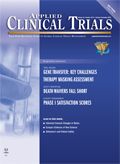
Improving Relationships and Diversifying the Site Selection Process
April 17th 2025In this episode of the Applied Clinical Trials Podcast, Liz Beatty, co-founder and chief strategy officer, Inato, discusses a number of topics around site engagement including community-based sites, the role of technology in improving site/sponsor relationships, how increased operational costs are impacting the industry, and more.
Behind the Buzz: Why Clinical Research Leaders Flock to SCOPE Summit
February 7th 2025In this episode, we meet with Micah Lieberman, Executive Conference Director for SCOPE Summit (Summit for Clinical Ops Executives) at Cambridge Innovation Institute. We will dive deep into the critical role of collaboration within the clinical research ecosystem. How do we bring together diverse stakeholders—sponsors, CROs, clinical trial tech innovators, suppliers, patients, sites, advocacy organizations, investors, and non-profits—to share best practices in trial design, program planning, innovation, and clinical operations? We’ll explore why it’s vital for thought leaders to step beyond their own organizations and learn from others, exchanging ideas that drive advancements in clinical research. Additionally, we’ll discuss the pivotal role of scientific conferences like SCOPE Summit in fostering these essential connections and collaborations, helping shape the future of clinical trials. Join us as we uncover how collective wisdom and cross-industry partnerships are transforming the landscape of clinical research.
FDA-Approved Gene Therapy Beqvez Shows Sustained Efficacy, Safety in Long-Term Hemophilia B Trial
April 17th 2025Beqvez (fidanacogene elaparvovec), an FDA-approved one-time gene therapy for hemophilia B, demonstrated sustained factor IX expression, low bleeding rates, and a favorable safety profile over long-term follow-up.